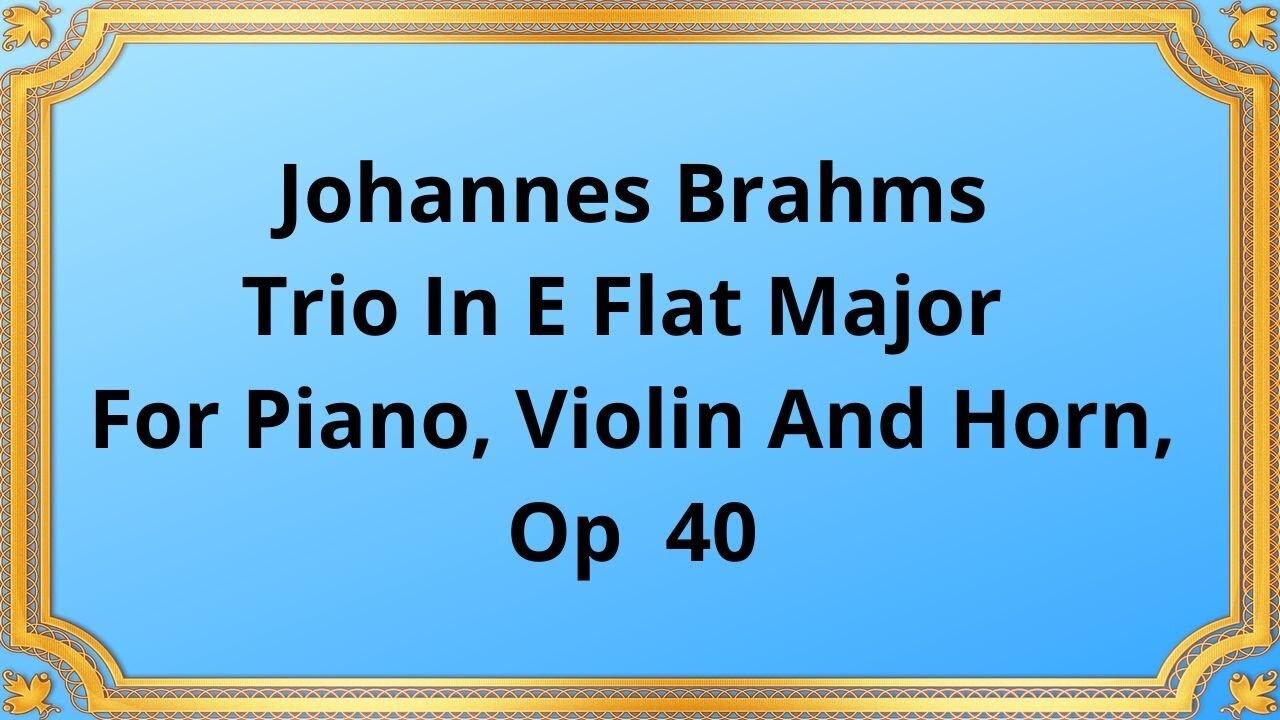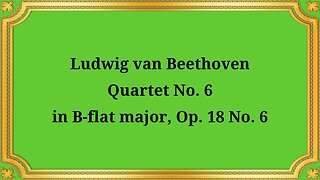Premium Only Content

Johannes Brahms Trio In E Flat Major For Piano, Violin And Horn, Op 40
#JohannesBrahms #TrioInEFlatMajor #Piano #Violin #Horn #Op40 #classicalmusic #musicalcomposition
Mieczyslaw Horszowski, Piano;
Alexander Schneider, Violin;
Mason Jones, Horn
Johannes Brahms, a prominent figure of the Romantic era, left an indelible mark on classical music through his rich and expressive compositions. Among his notable works, the Trio in E Flat Major for Piano, Violin, and Horn, Op. 40, stands as a testament to his mastery and innovation.
Born in 1833 in Germany, Brahms was a composer and pianist renowned for his meticulous craftsmanship and his ability to combine classical forms with intense emotional expression. His works are characterized by their richness, complexity, and harmonic depth.
Brahms' Trio in E Flat Major, a masterpiece composed in 1865, embodies the composer's musical genius and innovative spirit. It is a chamber music composition that brings together the piano, violin, and horn in a harmonious and profound dialogue. The Trio is structured in four movements, each offering a unique musical journey.
The Trio's first movement, marked Allegro con brio, sets the tone for the entire composition. It begins with a majestic piano introduction, followed by an assertive theme presented by the violin and echoed by the horn. Brahms skillfully weaves together melodies and harmonies, creating a sense of grandeur and emotional depth. The movement unfolds with a blend of dramatic and lyrical elements, showcasing Brahms' ability to evoke a range of emotions.
The second movement, Andante, presents a contrasting atmosphere of introspection and lyricism. The piano opens with a serene melody, accompanied by the delicate interplay of the violin and horn. Brahms' mastery is evident in the beautifully crafted melodies that intertwine, creating a sense of intimacy and introspection. The movement gradually unfolds with expressive variations, captivating the listener with its tender and emotive qualities.
The Trio's third movement, Un poco allegretto, injects a delightful sense of playfulness and rhythmic energy. Brahms introduces a spirited dance-like theme that is passed between the instruments, showcasing their individual virtuosity and collective synergy. This movement demonstrates Brahms' ability to blend technical prowess with melodic charm, leaving the listener captivated by its infectious energy.
The Trio concludes with a dramatic and vibrant final movement, marked Finale: Rondo all'Ongarese. Inspired by Hungarian folk music, Brahms incorporates lively and rhythmic motifs, creating a spirited and exhilarating musical experience. The movement showcases the interplay between the piano, violin, and horn, with each instrument taking turns to shine. Brahms' innovative approach to blending classical forms with folk influences is brilliantly showcased in this exhilarating finale.
Johannes Brahms' Trio in E Flat Major for Piano, Violin, and Horn, Op. 40, stands as a testament to his artistic brilliance and his ability to push the boundaries of musical expression. Its profound emotions, technical complexity, and harmonic richness continue to captivate audiences and inspire musicians. Brahms' Trio remains a cornerstone of chamber music repertoire, solidifying his legacy as one of the most influential composers of the Romantic era.
Conclusion:
Johannes Brahms' Trio in E Flat Major for Piano, Violin, and Horn, Op. 40, is a captivating masterpiece that exemplifies his exceptional talent and creativity. From the grandeur of the Allegro con brio to the introspective beauty of the Andante, and the playful energy of the Un poco allegretto to the vibrant finale of the Rondo all'Ongarese, Brahms takes listeners on a profound and emotive musical journey. This Trio stands as a testament to Brahms' enduring legacy and his significant contributions to the world of classical music.
You have the opportunity to support the channel:
https://destream.net/live/RadSiarAl/donate
https://www.buymeacoffee.com/6355radsiaral
-
 22:54
22:54
Classical music_Music Inspiration
23 hours agoLudwig van Beethoven Quartet No. 6 in B-flat major, Op. 18 No. 6
122 -
 3:17:28
3:17:28
TimcastIRL
5 hours agoTrans Shooter Targets Catholic Kids In Mass Shooting, Leftists Reject Prayers | Timcast IRL
220K60 -
 1:31:29
1:31:29
Brandon Gentile
1 day ago25 Year Wall Street INSIDER: $1M Bitcoin Soon Is Just The START
18.2K -
 LIVE
LIVE
SpartakusLIVE
7 hours ago#1 Birthday Boy Celebrates with MASSIVE and HUGE 4.8-Hour Stream
332 watching -
 55:54
55:54
Man in America
8 hours agoFrom Oil Barons to Pill Pushers: The Rockefeller War on Health w/ Jeff Adam
47K4 -
 3:02:18
3:02:18
Barry Cunningham
6 hours agoBREAKING NEWS: PRESIDENT TRUMP THIS INSANITY MUST END NOW!
92.8K160 -
 3:58:27
3:58:27
StevieTLIVE
5 hours agoWednesday Warzone Solo HYPE #1 Mullet on Rumble
37.8K -
 5:58
5:58
Mrgunsngear
6 hours ago $3.67 earnedBreaking: The New Republican Party Chairman Is Anti 2nd Amendment
23.2K8 -
 2:28:35
2:28:35
Geeks + Gamers
5 hours agoGeeks+Gamers Play- MARIO KART WORLD
24.6K -
![(8/27/2025) | SG Sits Down Again w/ Sam Anthony of [Your]News: Progress Reports on Securing "We The People" Citizen Journalism](https://1a-1791.com/video/fww1/d1/s8/6/G/L/3/c/GL3cz.0kob.1.jpg) 29:34
29:34
QNewsPatriot
6 hours ago(8/27/2025) | SG Sits Down Again w/ Sam Anthony of [Your]News: Progress Reports on Securing "We The People" Citizen Journalism
21.8K2